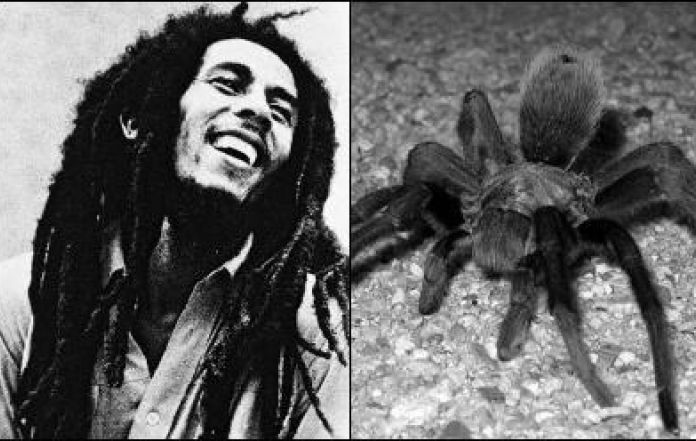STEPPIN’ RAZOR (Don’t you watch his size, he’s dangerous, dangerous.): This hairy-looking spider would give anyone the heebie jeebies. Researchers in Australia named him after Bob Marley.
[ad name=”HTML-68″] [wpedon id=”23995″ align=”left”]BRISBANE — Researchers from Queensland Museum have named a bizarre, scuba-diving spider who spends most of its time underwater after reggae legend Bob Marley.
Lead scientist Dr. Barbara Baehr said Desis bobmarleyi was a true marine spider that spent most of its lifetime living between corals in the Great Barrier Reef.
“Desis bobmarleyi is a small spider with a 6mm-long body and long hair like his namesake,” Dr. Baehr said in a statement.
“It uses this long hair on its legs and abdomen to create an air bubble around its middle that enables it to breathe and survive between the high and low tide zones.
“During high tide these extremely rare and unusual animals hide in the air chambers, but during low tide they are vagrant hunters found on corals, barnacles or debris.
“It was this behaviour that inspired us to name this new intertidal species in honour of Bob Marley’s hit song High Tide or Low Tide, which played during our field research in Queensland’s Port Douglas.
“We also felt that Desis bobmarleyi’s behaviour reflected Bob Marley’s adventurous and resilient spirit.”

Acting CEO of Queensland Museum, Dr Jim Thompson said this recent finding would help improve global knowledge about Australian spiders.
“Despite our country being widely recognised for its eight-legged inhabitants, scientists estimate that 70 per cent of Australia’s spider fauna has not yet been discovered or named,” Dr Thompson said.
“This latest discovery from Dr Barbara Baehr and Dr Robert Raven, who between them have described an incredible 1,000 new spider species, keeps us at the forefront of scientific research and adds to the 4,700 species of flora and fauna described by Queensland Museum since its conception in 1862.”

The research team also redescribe one of Desis bobmarleyi’s close relatives, Desis vorax from Sāmoa.
Dr Raven said Desis vorax was described 150 years ago by arachnologist L. Koch for the Godeffroy Collection — the oldest major collection of Australasian and Pacific spiders — at Hamburg University’s Centre of Natural History.
“The Godeffroy Collection dates back to the 1860s and is still the primary taxonomic reference for spiders in Australasia,” Dr Raven said.

“With no review of the classification of Desis spider species in the last 150 years, this research will be essential in reviewing the scientific classification of these fascinating spiders which are colonising reefs along many coast lines of the world.”
The research, published in Evolutionary Systematics was performed in collaboration with Dr Danilo Harms from Hamburg University’s Center of Natural History.




